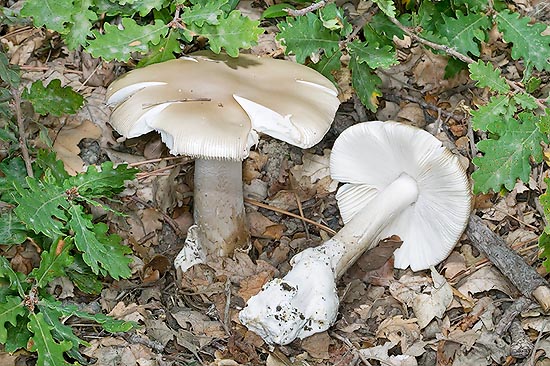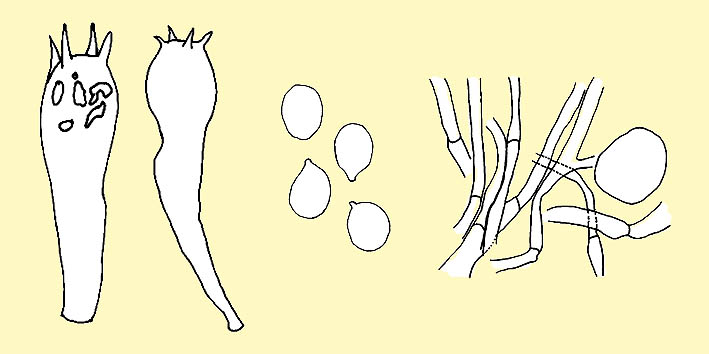
Text © Loredana Battisti

English translation by Mario Beltramini

Much variable colour but always pale. Fungus smell, sweetish taste © Giuseppe Mazza
Family: Amanitaceae Roze.
Genus: Amanita Persoon.
Subgenus: Amanita Singer.
Section : Vaginatae (Fr.) Quélet.
Amanita lividopallescens (Secretan ex Boudier) Kühner & Romagnesi 1953.
The name comes from the Latin lividus and pallescens: which becomes livid and pale; due to the colour of the cap.
The Section Vaginatae (ex Amanitopsis = Amanitas without ring), is characterized by basidiomata with prevailing filamentous hyphal structure, composed by extended cells, so that the general or universal veil which protects them during the first growth stage (primary), while tearing, persists almost integrally at the base of the stem, with the form of a volva, defined as sac-shaped, more or less wrapping, leaving on the surface of the cap some patches of variable size. They show the margin of the cap clearly “combed”, and absence of partial veil, since it forms only at embryonic level, to dissolve, later on, in thin flakes or stripes which decorate the stipe. We find Amanitas all edible after cooking, as they contain toxic but thermolabile substances (hemolysins), which dissolve with temperatures of 70-80 °C.
Cap: 8-15 cm, from hemispheric to convex to flat, finally flattened-depressed, briefly striped, of much variable, but always very pale, colouring: from white to cream-white, livid-grey, grey-cream, with stronger tones at the centre, with rare shreds or veiling patches of white colour.
Hymenophore: lamellae, on the average, thick, free to the stipe, with truncated white lamellulae, sharp floccose and concolorous. Spores print white.
Stipe: 9-15 x 1,5-3 cm, stout, cylindrical, slender, fistulous, attenuated at the apex and enlarged at the base, of white colour, then covered by concolorous flocks, or scaly concolorous stripes to the cap. Ring absent.

Amanita lividopallescens: basidia, spores, veil elements © Pierluigi Angeli
Sac volvaceous, ample and membranous, sheathing at the base with the upper part free, but soon frail, white, at times shaded of pale ochre.
Flesh: firm, then soft, persis- tently white when cut. Fungus odour, sweetish taste.
Chemical reactions: non-amyloid spores in contact with Melzer’s reagent.
Habitat: uncommon species, summer, early autumn, mainly in latifolious woods (oaks).
Edibility: edible after cooking.
Notes: not very common spe- cies, but easily recognizable for its colouring generally always clear, for a volva soon frail and a stem with concolorous flocks, which distinguish it from the A. vaginata .
Varieties and similar species:
Amanita separata Contu: identical, the only distinction is microscopic: mostly elliptical spores.
Amanita fraudolenta Contu = Amanita lividopallescens var. tigrina (Romagn. ex Bon) should have brown-striped stem and the edge of the lamellae dotted of the same colour.
Remarks: The distinction with Amanita beckeri and Amanita malleta is difficult, as they show very similar appearance, stoutness and pileus pigmentation. An element of distinction might be represented by the volva, which in Amanita lividopallescens, shows usually as more sac-like, in comparison with the one of the other two Amanitas, in which, on the contrary, it is frailer, but only the microscopic analysis might cancel any doubt.
→ For general notions about Fungi please click here.
→ To appreciate the biodiversity of MUSHROOMS please click here.
